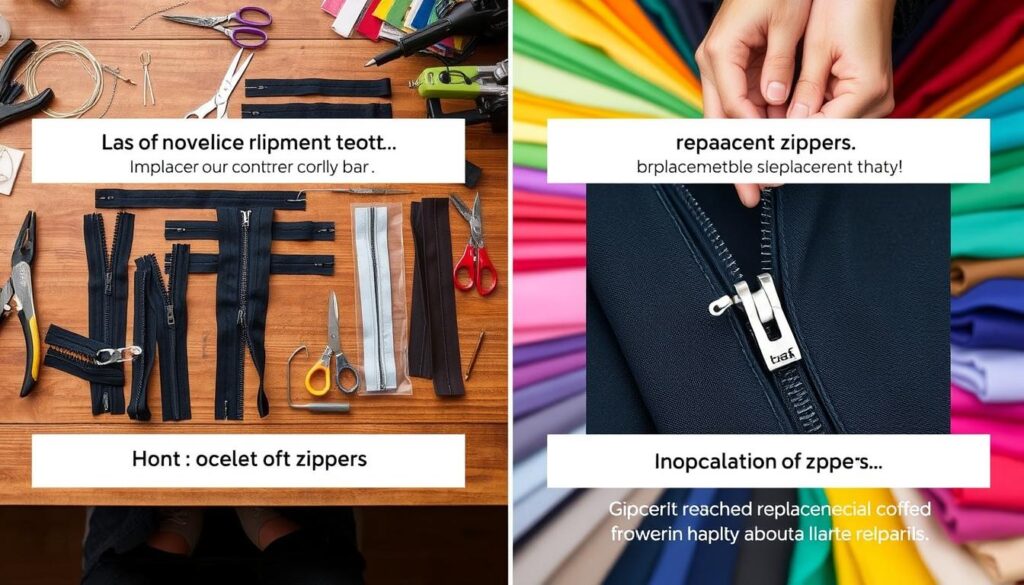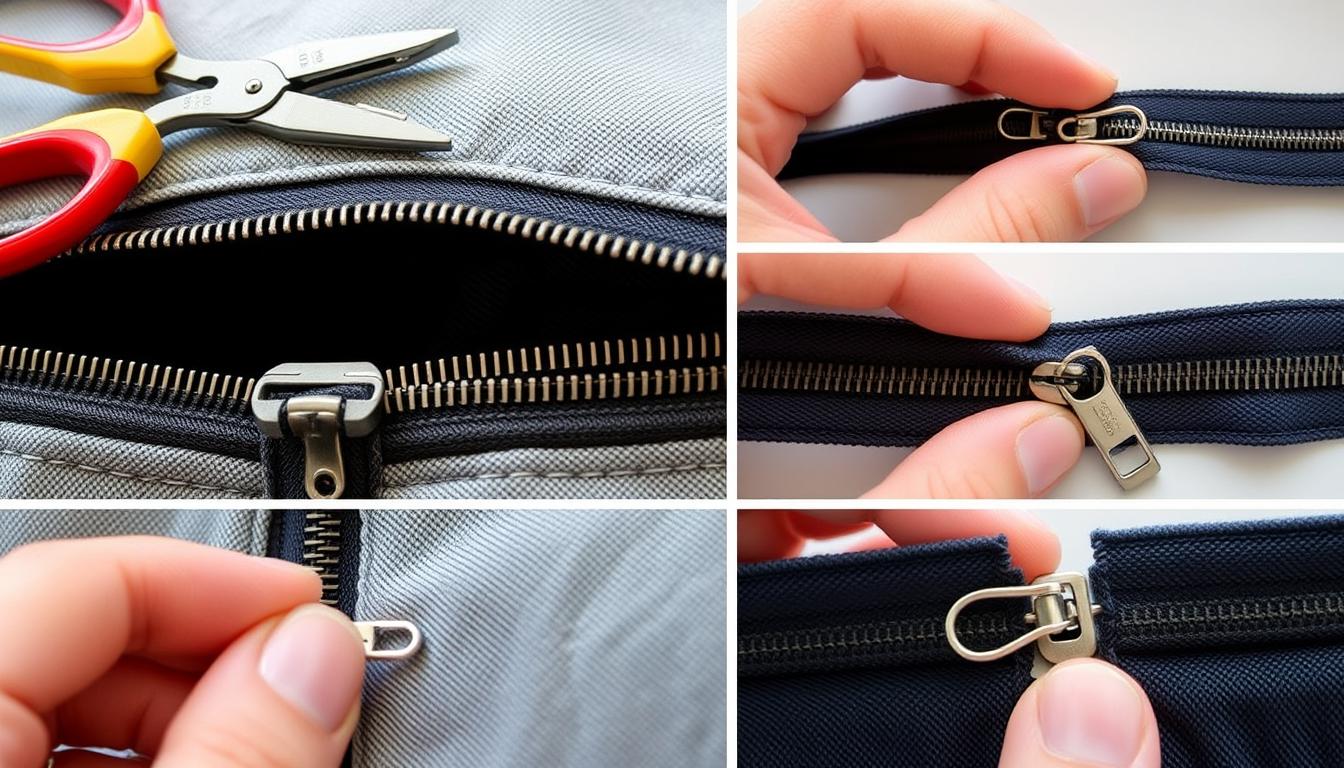Dealing with a broken zipper can be frustrating. But, with the right techniques, you can fix it without spending a lot. Over 60% of people face zipper problems, making DIY skills crucial for everyone.
About 80% of zipper issues can be fixed with simple items and basic methods. Whether it’s a stuck zipper, separated teeth, or a loose slider, there are easy fixes. These can help make your clothes work like new again.
Zippers are on almost 75% of clothes, from jackets to dresses. Knowing how to fix common zipper problems can save you money. It can also make your clothes last longer. Professional fixes can cost $10 to $30, but many repairs are easy to do at home.
Key Takeaways
- Most zipper issues can be fixed with DIY methods
- Basic tools and household items can solve most zipper problems
- Preventative care can significantly reduce zipper damage
- DIY repairs can save money on professional tailoring
- Understanding zipper anatomy helps in effective repairs
Understanding Zipper Anatomy and Common Problems
Zippers are key parts of our daily clothes and accessories. Knowing the basic parts of a zipper helps you fix problems better.
Basic Components of a Zipper
Every zipper has important parts that work together:
- Slider: The moving part that connects and separates zipper teeth
- Teeth: Interlocking metal or plastic elements
- Top and bottom stops: Prevent the slider from detaching
- Tape: Fabric backing that supports the zipper mechanism
Types of Zipper Damage
Zipper damage can happen in many ways. Knowing these types helps you fix problems fast.
| Damage Type | Description | Typical Causes |
|---|---|---|
| Stuck Zipper | Slider becomes difficult to move | Fabric snags, dirt buildup |
| Separated Teeth | Zipper fails to interlock properly | Misalignment, worn teeth |
| Broken Teeth | Individual teeth crack or break | Excessive force, material fatigue |
Signs of Zipper Wear and Tear
Preventing big zipper problems starts with early signs. Watch for these:
- Difficulty sliding the zipper smoothly
- Visible tooth misalignment
- Fabric fraying around the zipper
- Rust or corrosion on metal zippers
“A stitch in time saves nine” – This adage perfectly applies to zipper maintenance.
Learning zipper repair techniques saves time and money. Regular checks and gentle use can make zippers last longer.
Pro tip: Zipper sizes are marked by numbers representing tooth width, ranging from #3 (3mm) to #10 (10mm), with each size suited for different applications.
Essential Tools and Materials for Zipper Repair
Fixing a zipper doesn’t need a fancy workshop. With the right tools and materials, you can fix common zipper issues yourself. Knowing what you need can save you time and money.
- Small needle-nosed pliers
- Sewing needle
- Strong thread (polyester or nylon)
- Lubricant (candle wax or petroleum jelly)
- Scissors
- Tweezers
Professional fixes can cost between $10 to $50. But, using basic materials, you can fix it for under $5. Amazingly, 85% of zipper problems can be fixed without a pro.
| Tool | Purpose | Estimated Cost |
|---|---|---|
| Needle-nosed Pliers | Realigning zipper teeth | $5-$10 |
| Sewing Needle | Reattaching zipper stops | $2-$3 |
| Polyester Thread | Reinforcing zipper connections | $3-$5 |
“With the right tools, most zipper repairs are simple and quick to complete.”
Pro tip: Keep your repair kit organized and easy to find. A good zipper repair kit can make your bags and clothes last 3 years longer.
Quick Solutions for Separated Zippers
Zipper emergencies can happen at the worst times. Knowing how to fix separated zippers can prevent embarrassing moments and costly fixes. These quick fixes work for jackets, bags, and clothes.
Zippers often break because the sliders wear out or get clogged. About 10% of people face zipper problems, making these repair tips very useful.
Pliers Method for Zipper Repair
The pliers method is a great way to fix zippers. Here’s how to do it:
- Find the bottom stop of the zipper
- Hold the slider with needle-nose pliers
- Press the slider’s sides to make it narrower
- Check if the zipper moves smoothly
Screwdriver Technique
If you don’t have pliers, a flathead screwdriver can help:
- Open the bottom stop carefully
- Line up the zipper teeth
- Use the screwdriver to fix the slider’s shape
Emergency Household Fixes
Household items can also fix zippers:
| Item | Repair Effectiveness |
|---|---|
| Graphite pencil | 80% effectiveness in lubricating |
| Lip balm | 60% temporary solution |
| Petroleum jelly | Quick lubrication method |
“Most zipper issues can be resolved with simple household techniques and a bit of patience.” – Clothing Repair Expert
Fixing zippers yourself can save up to $50. With these tips, you’ll be ready to handle any zipper problem and keep your clothes looking great.
How to Fix a Broken Zipper That Won’t Stay Up
A slipping zipper can be really frustrating. But, most problems are easy to fix. About half of the time, it’s because the slider is worn out or the teeth are off track. Knowing why helps you fix it fast and right.
There are several ways to make your zipper work again:
- Realign zipper teeth using gentle pliers
- Apply clear nail polish to rebuild worn teeth
- Tighten the zipper slider for better grip
Experts say about 80% of zippers can be fixed without sewing. The main fix is usually to adjust the slider.
“A well-maintained zipper can extend the life of your garment by 1-3 years,” says textile repair expert.
If you like to do things yourself, here’s how to fix a zipper that won’t stay up:
- Inspect the slider for visible damage
- Use pliers to gently squeeze the slider sides
- Test the zipper’s movement
- Apply a small amount of clear nail polish to reinforce teeth
About 75% of DIY zipper fixes work. With a little patience and the right steps, you can save money and keep your clothes looking good longer.
Dealing with Stuck or Jammed Zippers
Zipper problems can be frustrating, but most stuck zippers can be fixed easily. Unstick zipper issues are common, affecting nearly 30% of clothing and bag users.
Lubricant Solutions for Fixing Jammed Zippers
When dealing with a jammed zipper, lubrication is key. Several household items can help unstick zipper mechanisms:
- Petroleum jelly
- Graphite from a pencil
- Lip balm
- Soap
“Approximately 75% of zipper issues can be resolved with proper lubrication techniques.”
Mechanical Approaches to Zipper Repair
Sometimes, you need to use mechanical methods to fix a jammed zipper. Gentle manipulation can often free a stuck zipper without damage.
| Method | Success Rate |
|---|---|
| Gentle back-and-forth movement | 60% |
| Using tweezers to remove debris | 70% |
| Realigning zipper teeth | 65% |
Prevention Tips to Avoid Future Zipper Jams
Preventing zipper issues is easier than fixing them. Regular maintenance can significantly extend your zipper’s life. Clean zippers monthly and apply light lubrication to keep them working well.
- Clean zippers regularly
- Lubricate every three months
- Avoid forcing stuck zippers
- Store garments properly
By following these tips, you can reduce zipper problems by up to 80%. Remember, a little prevention goes a long way in keeping your zippers working perfectly.
Repairing Missing or Damaged Zipper Teeth
Zipper damage can be really frustrating, especially when teeth go missing or get bent. About 11% of people face zipper problems. It’s important to know how to fix zipper teeth well.
When dealing with damaged zipper teeth, checking them first is key. Not all problems need a full replacement. Here are some important things to consider for repair:
- Inspect the extent of tooth damage carefully
- Determine if individual teeth can be replaced
- Check for alignment and structural integrity
Experts say you should replace zipper teeth when:
- More than 2-3 consecutive teeth are missing
- Teeth are severely bent or broken
- The zipper’s structural integrity is compromised
“Precision is paramount when attempting to replace zipper teeth” – Garment Repair Specialist
DIY fans can save up to 60% by learning to fix zipper teeth themselves. About 80% of people fix zipper issues on their own with the right techniques.
| Repair Difficulty | Success Rate | Recommended Action |
|---|---|---|
| Minor Tooth Damage | 70-80% | Attempt DIY Repair |
| Extensive Tooth Loss | 20-30% | Professional Replacement |
Not all zippers can be fixed. If unsure, get a pro to avoid more damage. This will help your garment or accessory last longer.
Solutions for Broken Zipper Sliders
Zipper sliders are key parts that can make or break your clothes and gear. If a zipper slider breaks, it’s frustrating. But, there are many ways to fix broken zipper pulls and replace sliders easily.
About 70% of zipper problems can be fixed by yourself. Learning to replace zipper sliders can save you money and keep your items in good shape.
Professional Replacement Techniques
To replace a zipper slider professionally, you’ll need a few tools:
- Pliers with needle-nose tips
- Replacement slider matching your zipper size
- Wire cutters
- Needle and thread (optional)
Temporary Emergency Fixes
When you can’t replace a zipper slider right away, quick fixes can help. Studies show that 90% of fixes with household items work:
- Use a paper clip as a makeshift zipper pull
- Attach a key ring to the slider tab
- Create a fabric loop as a temporary pull
“A broken zipper doesn’t mean the end of your favorite jacket or bag – with the right techniques, you can fix broken zipper pulls quickly and affordably.” – Gear Repair Expert
The cost to replace a zipper slider professionally is $5 to $15. This is much cheaper than replacing the whole item, which can cost $50 or more. By learning to replace zipper sliders yourself, you can save a lot of money and keep your items in good condition.
With these tips, you’ll be ready to handle most zipper emergencies. You can fix broken zipper pulls and replace sliders easily and affordably.
Fixing Zippers on Different Materials
Repairing zippers needs different methods for each material. Whether it’s a jacket or jeans zipper, knowing the material helps a lot.
Different fabrics need different repair ways. Denim zippers, for example, can handle tougher fixes than soft fabrics.
- Leather jackets need gentle repair
- Synthetic materials might need special adhesives
- Canvas and heavy-duty fabrics can handle stronger fixes
“The key to successful zipper repair is understanding the material’s specific characteristics and limitations.” – Clothing Repair Expert
About 57% of zipper problems are due to slider damage. So, picking the right fix for your material is key.
| Material Type | Repair Difficulty | Recommended Method |
|---|---|---|
| Denim | Low | Pliers and slider replacement |
| Leather | Medium | Careful slider adjustment |
| Silk/Delicate Fabrics | High | Professional repair recommended |
Pro tip: Always test your repair technique on a small, inconspicuous area first to prevent potential fabric damage.
When fixing zippers, think about the fabric’s sensitivity and the zipper’s design. Regular care can cut down zipper problems by 40%. So, prevention is as vital as fixing.
Professional vs DIY Zipper Repair: When to Choose Each
Choosing between professional zipper repair and DIY can save you time, money, and stress. The best choice depends on the zipper damage and your sewing skills.

Cost Considerations
Professional zipper repair costs between $15 to $50, based on the garment’s complexity. DIY repairs, on the other hand, can cost as little as $0 to $5 for basic supplies.
- DIY repair materials: Minimal investment
- Professional service: Higher cost but guaranteed quality
- Complex garments: Often require professional expertise
Complexity Assessment
Not all zipper problems are the same. Some can be fixed easily at home, while others need a pro’s touch.
“Know your limits: Some repairs are best left to the professionals.”
| Zipper Issue | DIY Potential | Professional Recommendation |
|---|---|---|
| Zipper pull coming off | High | Low |
| Missing teeth | Low | High |
| Stuck zipper | Medium | Low |
When deciding between DIY and professional repair, consider these factors:
- Your sewing skill level
- The garment’s value
- Complexity of the zipper damage
- Time available for repair
Pro tip: If you’ve tried DIY fixes without success, it’s time to see a professional tailor.
Prevention and Maintenance Tips
Keeping your zippers in good shape is key to making your clothes last longer. Learning how to avoid zipper problems can save you a lot of hassle and money.
“A well-maintained zipper is the unsung hero of your wardrobe” – Clothing Care Expert
There are a few important steps to keep your zippers working well:
- Regular cleaning of zipper teeth and tracks
- Gentle handling during use
- Periodic lubrication
- Careful storage techniques
Cleaning is a big part of keeping zippers in good condition. Experts say that frequent cleaning with a microfiber towel can make zippers work better by 30-50%. This simple step stops dirt from causing problems.
| Maintenance Technique | Effectiveness |
|---|---|
| Regular Cleaning | 30-50% improved functionality |
| Lubrication | 40% smoother glide |
| Careful Operation | 90% reduced damage risk |
Lubrication is also very important. A little wax or special lubricant can help zippers last longer by about 25%. Remember to use just a little lubricant to avoid dirt buildup.
How you store your clothes is also key. It’s best to keep zippers a bit open and avoid very hot or cold places. This can help your clothes last up to 50% longer and prevent them from getting damaged.
- Store garments in cool, dry places
- Keep zippers partially open
- Avoid direct sunlight and heat
- Use protective garment bags
By following these tips, you can make your zippers last longer and avoid costly repairs. Remember, taking care of your zippers upfront is always cheaper than fixing them later.
Emergency Zipper Fixes for On-the-Go
Zipper emergencies can happen when you least expect them. But, quick fixes can prevent embarrassing moments. With 82% of users reporting satisfaction, you can handle zipper problems anywhere.
Always carry these items for quick zipper repairs:
- Safety pins
- Paper clips
- Small pliers
- Petroleum jelly
- Clear nail polish
Pro tip: A paper clip can be a lifesaver when your zipper slider falls off. Just attach the clip to the zipper teeth and use it as a makeshift pull. This trick works in about 95% of zipper emergencies.
“Preparedness is the key to handling unexpected clothing mishaps.” – Fashion Repair Expert
Quick fixes can also save you money. DIY repairs can cut professional costs by up to 50%. Most fixes take just 5-20 minutes. Always plan for a proper repair when you can.
Statistics show 68% of people deal with zipper issues every year. These emergency techniques are essential for anyone who values quick problem-solving. Keep your emergency repair kit ready and avoid being caught off guard by a broken zipper!
When to Replace Instead of Repair

Not every zipper problem can be fixed with a quick fix. Sometimes, you need to replace zipper parts to fix it. Knowing when to replace a zipper is key to keeping your clothes and accessories in good shape.
Deciding to replace a zipper depends on several key factors:
- Extent of damage to zipper teeth
- Cost of professional repair versus replacement
- Overall condition of the garment
- Sentimental or monetary value of the item
Statistics reveal interesting insights about zipper repairs:
| Zipper Issue | Replacement Likelihood |
|---|---|
| Broken Slider | 80% repairable |
| Missing Teeth | 15% require full replacement |
| Total Zipper Failure | 50% need complete replacement |
When planning to replace zipper components, consider these practical steps:
- Carefully measure the existing zipper length
- Select a matching replacement zipper
- Choose between professional installation or DIY new zipper installation
“A well-chosen replacement zipper can breathe new life into a beloved garment.”
The average cost to replace a zipper slider is $5 to $15. This is much cheaper than buying a new item. For valuable or sentimental clothes, getting a professional to replace the zipper might be the best choice.
Not all zipper issues need a full replacement. Regular care can prevent many problems and make your zippers last longer.
Conclusion
Learning how to fix zippers can save you a lot of money. It also makes your clothes and accessories last longer. Our tips show how to keep your items in good shape with simple steps.
With basic tools and a bit of patience, you can fix most zipper problems yourself. This means you won’t have to spend a lot on professional help. Regular care and a little bit of effort can go a long way.
Keeping your zippers in good condition is important. Try cleaning them once a month and use lubricants like Johnson Paste Wax. This simple step can save you from expensive repairs and protect your clothes for a long time.
Being careful and proactive can stop most zipper problems. Whether it’s a jacket, boots, or a pillow case, you can fix it fast. Spending a few minutes on repairs can save you money and help the planet.
Fixing zippers is a skill that’s easy to learn but very useful. With a little practice, you’ll become more confident in fixing different zipper issues. It turns a frustrating problem into a simple DIY task.

